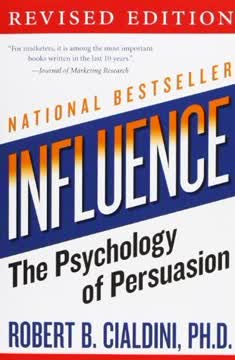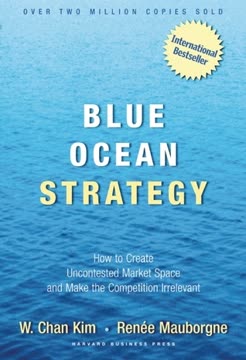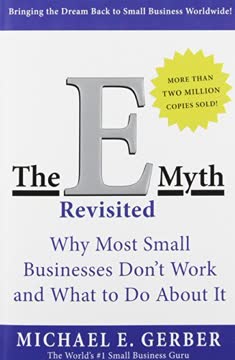मुख्य निष्कर्ष
1. ई-मिथ: अधिकांश छोटे व्यवसाय उद्यमी मिथक के कारण असफल होते हैं
ई-मिथ उद्यमी का मिथक है। यह देश में गहराई से जड़ा हुआ है और इसमें नायकत्व की झलक मिलती है।
उद्यमी मिथक यह गलत धारणा है कि अधिकांश व्यवसाय उद्यमियों द्वारा शुरू किए जाते हैं जिनके पास व्यापार का ज्ञान होता है। असलियत में, अधिकांश व्यवसाय तकनीशियनों द्वारा शुरू किए जाते हैं जो काम करना जानते हैं लेकिन व्यापार कौशल से वंचित होते हैं। इससे असफलता होती है क्योंकि:
- केवल तकनीकी कौशल सफल व्यवसाय चलाने के लिए पर्याप्त नहीं होते
- कई व्यवसाय मालिक अपने व्यवसाय में काम करते हैं, व्यवसाय पर काम नहीं करते
- मालिक सब कुछ खुद करने की कोशिश में थक जाता है
ई-मिथ बताता है कि क्यों 40% नए व्यवसाय पहले वर्ष में और 80% पांच वर्षों में असफल हो जाते हैं। सफल होने के लिए, व्यवसाय मालिकों को व्यवसाय में काम करने से व्यवसाय पर काम करने की ओर ध्यान केंद्रित करना होगा।
2. उद्यमी, प्रबंधक और तकनीशियन: हर व्यवसायी के तीन व्यक्तित्व
उद्यमी भविष्य में रहता है, कभी अतीत में नहीं, और शायद ही वर्तमान में। वह "क्या होगा अगर" और "अगर-जब" की कल्पनाओं में सबसे खुश रहता है।
हर व्यवसायी के तीन व्यक्तित्व होते हैं:
-
उद्यमी: दूरदर्शी और स्वप्नदर्शी
- अवसर देखता है और दिशा निर्धारित करता है
- नियंत्रण चाहता है और बदलाव लाता है
-
प्रबंधक: व्यावहारिक योजनाकार
- व्यवस्था चाहता है और सिस्टम बनाता है
- संरचना को व्यवस्थित और बनाए रखता है
-
तकनीशियन: कार्यकर्ता और कर्मठ
- वर्तमान पर ध्यान केंद्रित करता है और काम पूरा करता है
- दिनचर्या और व्यावहारिक काम में सहज रहता है
अधिकांश छोटे व्यवसायी 10% उद्यमी, 20% प्रबंधक और 70% तकनीशियन होते हैं। यह असंतुलन व्यवसाय के विकास में समस्याएं लाता है। सफलता के लिए इन व्यक्तित्वों का संतुलन और उद्यमी तथा प्रबंधकीय पक्षों का विकास आवश्यक है।
3. व्यवसाय विकास प्रक्रिया: अपने व्यवसाय पर काम करें, उसमें नहीं
आपका व्यवसाय आपकी ज़िंदगी नहीं है।
अपने व्यवसाय पर काम करने का मतलब है:
- अपने व्यवसाय को एक उत्पाद की तरह विकसित करना
- ऐसे सिस्टम बनाना जो आपके बिना भी व्यवसाय चलाएं
- तकनीकी काम की बजाय रणनीतिक काम पर ध्यान देना
इसके लिए करें:
- व्यवसाय विकास कार्यक्रम बनाएं
- फ्रैंचाइज़ प्रोटोटाइप तैयार करें (चाहे फ्रैंचाइज़ी न बनानी हो)
- व्यवसाय के हर पहलू के लिए सिस्टम लागू करें
- सभी प्रक्रियाओं को संचालन मैनुअल में दस्तावेजित करें
इससे आप:
- एक ऐसा व्यवसाय बनाएंगे जिसे दोहराया जा सके
- अपनी व्यक्तिगत मेहनत से परे मूल्य बनाएंगे
- रोज़मर्रा के कामों से स्वतंत्रता पाएंगे
4. टर्न-की क्रांति: सफलता के लिए फ्रैंचाइज़िंग मॉडल
व्यवसाय का असली उत्पाद स्वयं व्यवसाय है।
टर्न-की क्रांति, जैसा कि रे क्रोक के मैकडॉनल्ड्स ने दिखाया, यह सिद्ध करती है:
- एक ऐसा व्यवसाय सिस्टम बनाना जो दोहराया जा सके
- निरंतरता और मानकीकरण का महत्व
- केवल उत्पाद नहीं, व्यवसाय मॉडल पर ध्यान देना
फ्रैंचाइज़ मॉडल के मुख्य पहलू:
- दस्तावेजीकृत सिस्टम और प्रक्रियाएं
- मानकीकृत संचालन
- दोहराने और विस्तार योग्य मॉडल
चाहे आप फ्रैंचाइज़ी न बनाएं, इस सोच को अपनाने से:
- व्यवसाय का मूल्य बढ़ेगा
- दक्षता और निरंतरता सुधरेगी
- विस्तार और विकास आसान होगा
5. आपकी प्राथमिक लक्ष्य: अपनी व्यक्तिगत दृष्टि और जीवन लक्ष्य निर्धारित करें
मैं चाहता हूँ कि मेरा जीवन कैसा दिखे?
आपका प्राथमिक लक्ष्य आपकी व्यक्तिगत जीवन दृष्टि है, जिसमें शामिल हैं:
- आपके मूल्य और प्राथमिकताएं
- आप जो प्रभाव छोड़ना चाहते हैं
- आप कैसे याद किए जाना चाहते हैं
प्राथमिक लक्ष्य विकसित करने के लिए:
- अपने आदर्श जीवन की कल्पना करें
- अपने व्यक्तिगत और पेशेवर लक्ष्य निर्धारित करें
- अपने मूल मूल्य और सिद्धांत पहचानें
आपका प्राथमिक लक्ष्य:
- आपके व्यवसाय निर्णयों का मार्गदर्शन करे
- आपके व्यवसाय को आपकी व्यक्तिगत आकांक्षाओं के साथ संरेखित करे
- वित्तीय सफलता से परे प्रेरणा और उद्देश्य प्रदान करे
6. आपकी रणनीतिक उद्देश्य: अपने व्यवसाय के लिए स्पष्ट दृष्टि बनाएं
मैं कैसे अपने व्यवसाय को चलाऊं, लेकिन बिना मेरे?
आपका रणनीतिक उद्देश्य स्पष्ट रूप से बताता है कि आपका व्यवसाय अंततः क्या करना चाहिए ताकि आपका प्राथमिक लक्ष्य पूरा हो सके। इसमें शामिल हैं:
-
वित्तीय लक्ष्य:
- कुल राजस्व
- लाभ
- निवेश पर रिटर्न
-
व्यवसाय मॉडल:
- व्यवसाय का प्रकार
- लक्षित बाजार
- अनूठा विक्रय प्रस्ताव
-
मानक और मापदंड:
- गुणवत्ता मानक
- ग्राहक सेवा अपेक्षाएं
- संचालन मेट्रिक्स
आपका रणनीतिक उद्देश्य:
- विशिष्ट और मापनीय होना चाहिए
- आपके प्राथमिक लक्ष्य के अनुरूप होना चाहिए
- ऐसा व्यवसाय बनाना चाहिए जो आपके बिना काम करे
7. संगठनात्मक रणनीति: विकास का समर्थन करने वाली संरचना बनाएं
आपकी संगठनात्मक चार्ट आपके रणनीतिक उद्देश्य से निकलती है, जो आपके प्राथमिक लक्ष्य से निकलती है।
संगठनात्मक रणनीति बनाएं:
-
संगठनात्मक चार्ट विकसित करें:
- एक पूर्ण कार्यशील व्यवसाय के लिए सभी पदों को परिभाषित करें
- केवल वर्तमान जरूरतों के लिए नहीं, भविष्य के विकास के लिए भी पद शामिल करें
-
पद अनुबंध बनाएं:
- प्रत्येक पद की जिम्मेदारियां और जवाबदेहियां स्पष्ट करें
- प्रदर्शन के लिए मानक और अपेक्षाएं निर्धारित करें
-
प्रोटोटाइप दृष्टिकोण लागू करें:
- शुरुआत में सभी पद खुद भरें
- प्रत्येक भूमिका को दस्तावेजित और सिस्टमाइज़ करें
- धीरे-धीरे खुद को कर्मचारियों या सिस्टम से बदलें
इससे आप:
- अपने व्यवसाय के सभी पहलुओं को समझेंगे
- स्केलेबल सिस्टम और प्रक्रियाएं बनाएंगे
- ऐसा व्यवसाय बनाएंगे जो आपके बिना चल सके
8. प्रबंधन रणनीति: कुशल लोगों पर निर्भर न होकर सिस्टम बनाएं
सिस्टम समाधान है।
प्रबंधन रणनीति विकसित करें जो सिस्टम पर केंद्रित हो:
-
प्रबंधन सिस्टम बनाएं:
- निर्णय लेने की प्रक्रियाओं को मानकीकृत करें
- सुसंगत नीतियां और प्रक्रियाएं लागू करें
- मेट्रिक्स और ट्रैकिंग सिस्टम विकसित करें
-
समन्वय पर ध्यान दें:
- संचालन स्तर पर विवेक को समाप्त करें
- पूर्वानुमेय, दोहराने योग्य प्रक्रियाएं बनाएं
- ग्राहक अनुभव में निरंतरता सुनिश्चित करें
-
सतत सुधार लागू करें:
- नियमित रूप से सिस्टम की समीक्षा और अपडेट करें
- कर्मचारियों से प्रक्रियाओं पर प्रतिक्रिया प्रोत्साहित करें
- बदलते बाजार की परिस्थितियों के अनुसार अनुकूल रहें
इससे आप:
- अत्यधिक कुशल व्यक्तियों पर निर्भरता कम करेंगे
- विकास के साथ निरंतरता बनाए रखेंगे
- दक्षता बढ़ाएंगे और त्रुटियों को कम करेंगे
9. लोगों की रणनीति: अपने कर्मचारियों के लिए एक ऐसा खेल बनाएं जिसमें वे खेलना चाहें
लोग केवल उत्साही लोगों के लिए काम नहीं करना चाहते। वे ऐसे लोगों के लिए काम करना चाहते हैं जिन्होंने दुनिया में कार्य करने के लिए स्पष्ट संरचना बनाई हो।
लोगों की रणनीति विकसित करें जो:
-
आकर्षक कंपनी संस्कृति बनाए:
- अपनी कंपनी के मूल्य और मिशन परिभाषित करें
- स्पष्ट नियम और अपेक्षाएं स्थापित करें
- लाभ से परे उद्देश्य की भावना को बढ़ावा दें
-
प्रभावी प्रशिक्षण और विकास लागू करें:
- मानकीकृत प्रशिक्षण कार्यक्रम बनाएं
- स्पष्ट करियर पथ और विकास के अवसर प्रदान करें
- निरंतर सीखने और सुधार को प्रोत्साहित करें
-
व्यक्तिगत लक्ष्यों को कंपनी के उद्देश्यों के साथ संरेखित करें:
- स्पष्ट प्रदर्शन अपेक्षाएं सेट करें
- नियमित प्रतिक्रिया और समीक्षा प्रक्रियाएं लागू करें
- कंपनी के मूल्यों और लक्ष्यों के साथ संरेखण को पुरस्कृत करें
इससे आप:
- गुणवत्ता वाले कर्मचारियों को आकर्षित और बनाए रखेंगे
- जुड़ाव और उत्पादकता बढ़ाएंगे
- एक सकारात्मक कार्य वातावरण बनाएंगे जो आपके व्यवसाय के लक्ष्यों का समर्थन करता है
10. विपणन रणनीति: अपने ग्राहक की अवचेतन आवश्यकताओं को समझें
वास्तविकता केवल किसी की धारणाओं, दृष्टिकोणों, विश्वासों, निष्कर्षों में मौजूद होती है—जिन्हें आप मन की उन स्थितियों के रूप में कह सकते हैं जिनसे सभी अपेक्षाएं उत्पन्न होती हैं—और कहीं नहीं।
विपणन रणनीति विकसित करें जो:
-
अपने ग्राहक को समझे:
- अपने लक्षित जनसांख्यिकी को परिभाषित करें
- मनोवैज्ञानिक कारकों (दृष्टिकोण, विश्वास, मूल्य) का शोध करें
- अवचेतन आवश्यकताओं और इच्छाओं की पहचान करें
-
एक आकर्षक ब्रांड बनाए:
- एक अनूठा विक्रय प्रस्ताव विकसित करें
- ऐसे दृश्य और संदेश डिजाइन करें जो आपके लक्षित बाजार से मेल खाते हों
- सभी संपर्क बिंदुओं पर अपने ब्रांड को लगातार संप्रेषित करें
-
विपणन के लिए एक प्रणालीबद्ध दृष्टिकोण लागू करें:
- लीड जनरेशन के लिए दोहराने योग्य प्रक्रियाएं विकसित करें
- लीड को ग्राहक में बदलने के लिए सिस्टम बनाएं
- विपणन प्रभावशीलता को ट्रैक और सुधारने के लिए मेट्रिक्स स्थापित करें
इससे आप:
- अपने लक्षित बाजार से गहराई से जुड़ेंगे
- ऐसे विपणन संदेश बनाएंगे जो भावनात्मक स्तर पर प्रतिध्वनित हों
- एक सुसंगत और प्रभावी विपणन प्रणाली विकसित करेंगे
11. सिस्टम रणनीति: हार्ड, सॉफ्ट और सूचना सिस्टम लागू करें
सिस्टम चीजों, क्रियाओं, विचारों और सूचनाओं का एक समूह है जो एक-दूसरे के साथ इंटरैक्ट करता है, और ऐसा करते हुए अन्य सिस्टमों को बदलता है।
सिस्टम रणनीति विकसित करें जिसमें शामिल हों:
-
हार्ड सिस्टम:
- आपके व्यवसाय के भौतिक घटक (उपकरण, सुविधाएं आदि)
- मानकीकृत उपकरण और संसाधन
- जहां संभव हो स्वचालित प्रक्रियाएं
-
सॉफ्ट सिस्टम:
- लोगों से संबंधित प्रक्रियाएं (भर्ती, प्रशिक्षण, ग्राहक सेवा)
- कंपनी संस्कृति और मूल्य
- निर्णय लेने के ढांचे
-
सूचना सिस्टम:
- डेटा संग्रह और विश्लेषण उपकरण
- प्रदर्शन ट्रैकिंग और रिपोर्टिंग
- वित्तीय प्रबंधन सिस्टम
इन सिस्टमों को एकीकृत करने से आप:
- अधिक कुशल और सुसंगत संचालन बनाएंगे
- व्यक्तिगत प्रदर्शन पर निर्भरता कम करेंगे
- सतत सुधार के लिए डेटा-आधारित निर्णय लेंगे
अपने सिस्टम रणनीति को लागू करें:
- सभी प्रक्रियाओं को संचालन मैनुअल में दस्तावेजित करके
- नियमित प्रशिक्षण और सिस्टमों की पुनः पुष्टि करके
- सभी सिस्टमों की निरंतर समीक्षा और सुधार करके
अंतिम अपडेट:
FAQ
What's "The E-Myth Revisited" about?
- Small Business Challenges: "The E-Myth Revisited" by Michael E. Gerber explores why most small businesses fail and what can be done to prevent it. It debunks the myth that most businesses are started by entrepreneurs.
- Three Personalities: The book introduces the concept of the Entrepreneur, Manager, and Technician, explaining how these roles conflict within a small business owner.
- Business Development: It emphasizes the importance of working on your business, not just in it, by developing systems that allow the business to function without the owner’s constant involvement.
- Franchise Prototype: Gerber advocates for creating a business model that can be replicated, similar to a franchise, to ensure consistency and success.
Why should I read "The E-Myth Revisited"?
- Practical Advice: The book offers practical advice for small business owners to transform their businesses into efficient, systematized operations.
- Understanding Roles: It helps readers understand the different roles they play in their business and how to balance them effectively.
- Long-term Success: Gerber provides strategies for achieving long-term success by focusing on systems and processes rather than just the product or service.
- Inspiration and Motivation: The book is both inspirational and motivational, encouraging business owners to rethink their approach and reignite their passion for their business.
What are the key takeaways of "The E-Myth Revisited"?
- Work on Your Business: Focus on building systems that allow your business to run without you, rather than being trapped in day-to-day operations.
- Balance Roles: Recognize and balance the roles of Entrepreneur, Manager, and Technician within yourself to avoid internal conflict and business failure.
- Franchise Model: Develop your business as a prototype that can be replicated, ensuring consistency and quality in every aspect.
- Customer Focus: Understand your customer’s needs and design your business to meet those needs consistently and predictably.
What is the Entrepreneurial Myth according to Michael E. Gerber?
- Misconception: The Entrepreneurial Myth, or E-Myth, is the false belief that most businesses are started by entrepreneurs with a clear vision and plan.
- Reality: In reality, most businesses are started by technicians who are skilled at a particular task but lack the entrepreneurial skills to run a business.
- Consequences: This misconception leads to business owners being overwhelmed by the demands of running a business, often resulting in failure.
- Solution: Gerber suggests that understanding and addressing this myth is crucial for creating a successful business.
How does Michael E. Gerber define the roles of Entrepreneur, Manager, and Technician?
- Entrepreneur: The visionary who focuses on the future and innovation, driving change and growth within the business.
- Manager: The organizer who creates order and systems, ensuring that the business runs smoothly and efficiently.
- Technician: The doer who focuses on the present, performing the technical work that the business is built upon.
- Conflict: These roles often conflict within a business owner, leading to chaos if not properly balanced and managed.
What is the Franchise Prototype model in "The E-Myth Revisited"?
- Systematization: The Franchise Prototype model involves creating a business system that can be replicated consistently, much like a franchise.
- Predictability: It ensures that every aspect of the business is predictable and can deliver the same quality and experience to every customer.
- Scalability: By developing a prototype, the business can be scaled and expanded without losing its core values and quality.
- Focus on Process: The model emphasizes the importance of focusing on how the business operates, not just what it sells.
What is the Business Development Process in "The E-Myth Revisited"?
- Three Components: The Business Development Process consists of Innovation, Quantification, and Orchestration.
- Innovation: Continuously improving and finding better ways to do things within the business.
- Quantification: Measuring the impact of innovations to ensure they are effective and contribute to the business’s success.
- Orchestration: Creating systems that eliminate discretion at the operational level, ensuring consistency and reliability.
How does "The E-Myth Revisited" suggest handling management and people?
- Management System: Develop a management system that focuses on processes rather than relying on highly skilled individuals.
- Training and Development: Train employees to follow systems and processes, ensuring that the business can operate smoothly without constant supervision.
- Empowerment: Empower employees by providing them with clear guidelines and expectations, allowing them to perform their roles effectively.
- Consistency: Ensure that all employees understand and adhere to the business’s systems to maintain consistency and quality.
What marketing strategies does Michael E. Gerber recommend in "The E-Myth Revisited"?
- Customer Focus: Understand your customer’s needs and design your business to meet those needs consistently.
- Demographics and Psychographics: Use demographic and psychographic data to tailor your marketing efforts and reach your target audience effectively.
- Integrated Process: View marketing as an integrated process that includes lead generation, conversion, and client fulfillment.
- Differentiation: Differentiate your business by delivering a unique and consistent experience that sets you apart from competitors.
What are the best quotes from "The E-Myth Revisited" and what do they mean?
- "Work on your business, not in it." This quote emphasizes the importance of developing systems that allow the business to function independently of the owner.
- "The problem is not your business; the problem is you." Gerber highlights the need for business owners to change their mindset and approach to achieve success.
- "Your business is nothing more than a distinct reflection of who you are." This quote underscores the idea that a business reflects the owner’s values, skills, and vision.
- "The system is the solution." Gerber stresses that creating effective systems is the key to solving business problems and achieving consistent results.
How does "The E-Myth Revisited" address the concept of systems in business?
- Three Types of Systems: The book identifies three types of systems: Hard Systems, Soft Systems, and Information Systems.
- Integration: These systems must be integrated to create a cohesive and efficient business operation.
- Hard Systems: Physical components like equipment and facilities that support business operations.
- Soft Systems: Processes and procedures that guide how work is done, including scripts and training programs.
What is the significance of the Primary Aim in "The E-Myth Revisited"?
- Life Vision: The Primary Aim is about defining what you want your life to look like and how your business will support that vision.
- Purpose and Direction: It provides purpose and direction, ensuring that your business aligns with your personal goals and values.
- Decision-Making: Having a clear Primary Aim helps in making decisions that are consistent with your long-term objectives.
- Foundation: It serves as the foundation for all business strategies and decisions, ensuring that the business serves your life, not the other way around.
समीक्षाएं
द ई-मिथ रिविजिटेड को मिली-जुली प्रतिक्रियाएँ मिली हैं। कई लोग इसकी छोटी व्यवसाय प्रबंधन पर दी गई समझदारी की प्रशंसा करते हैं, खासकर सिस्टम्स की अहमियत, व्यवसाय के अंदर काम करने के बजाय उसके ऊपर काम करने की जरूरत, और तकनीशियन, प्रबंधक तथा उद्यमी की भूमिकाओं के बीच के अंतर को उजागर करने के लिए। पाठक इसके व्यवसाय विकास और फ्रेंचाइज़िंग के विचारों पर दी गई सलाह को उपयोगी पाते हैं। हालांकि, आलोचक इसे दोहरावपूर्ण, पुराना और खराब लिखित मानते हैं, और कुछ को इसमें शामिल काल्पनिक केस स्टडी और संवाद परेशान करने वाले लगते हैं। इन आलोचनाओं के बावजूद, कई लोग इसे उद्यमियों और छोटे व्यवसाय मालिकों के लिए अवश्य पढ़ने योग्य मानते हैं।
Similar Books



















